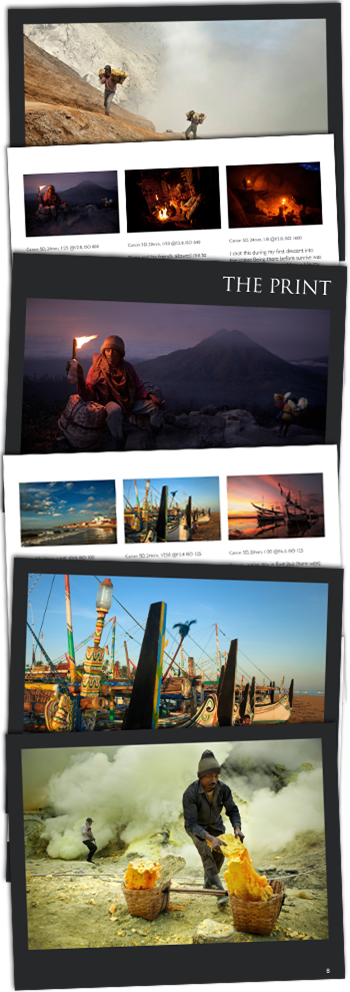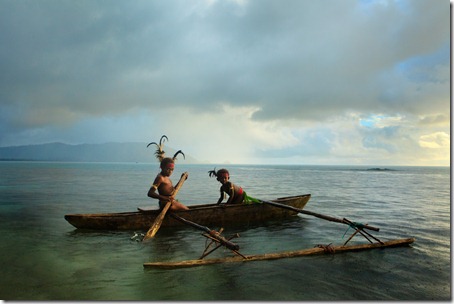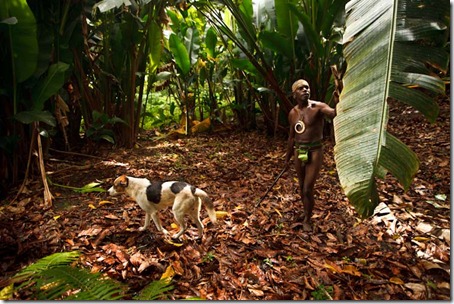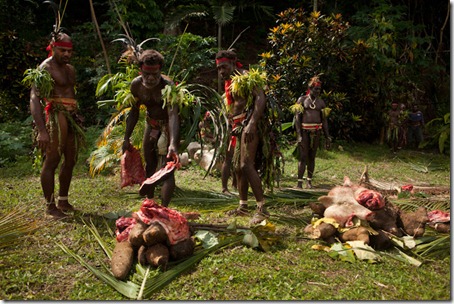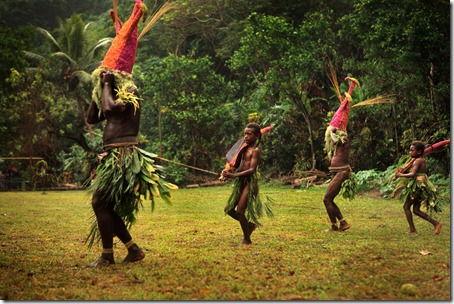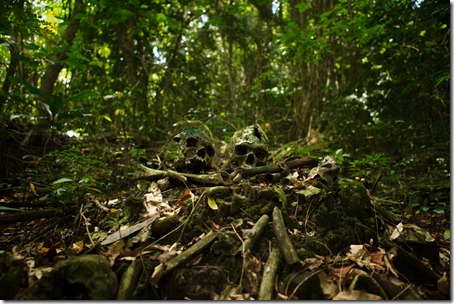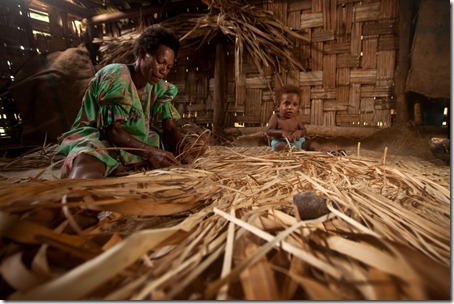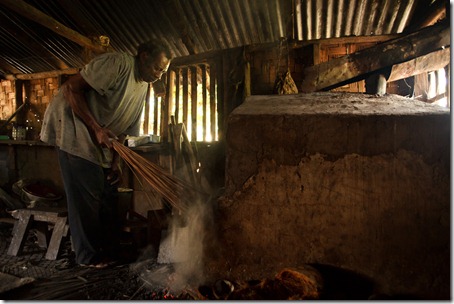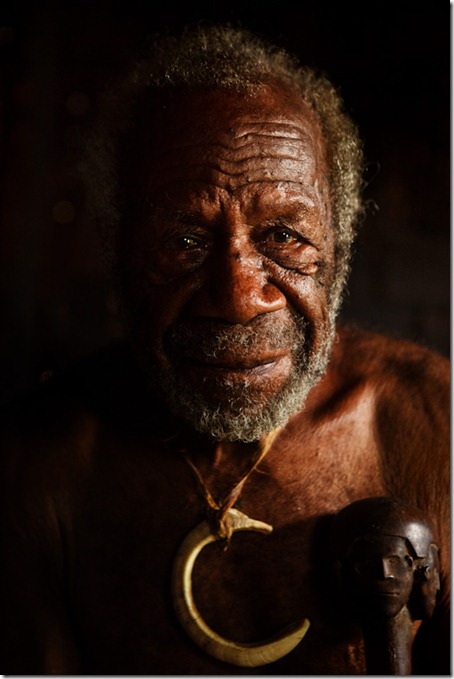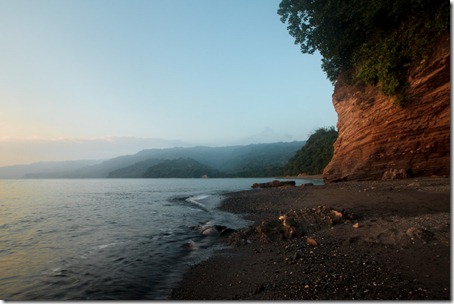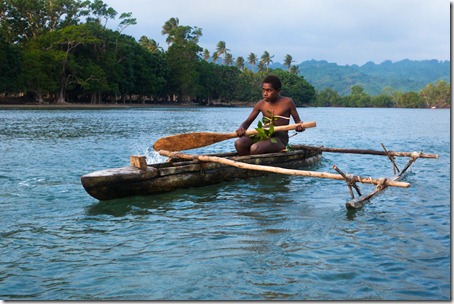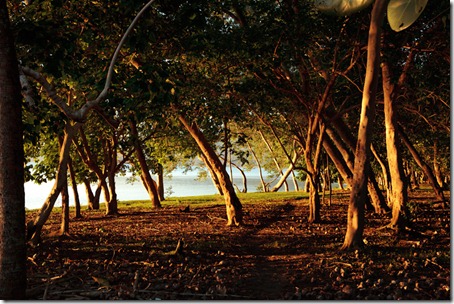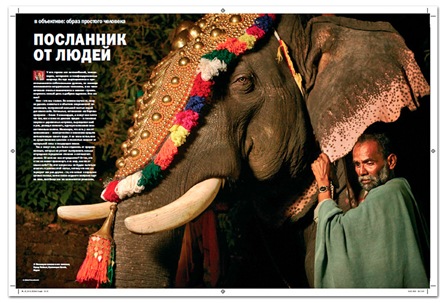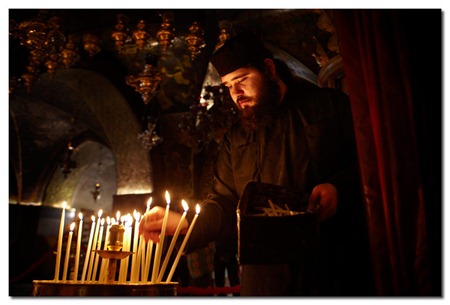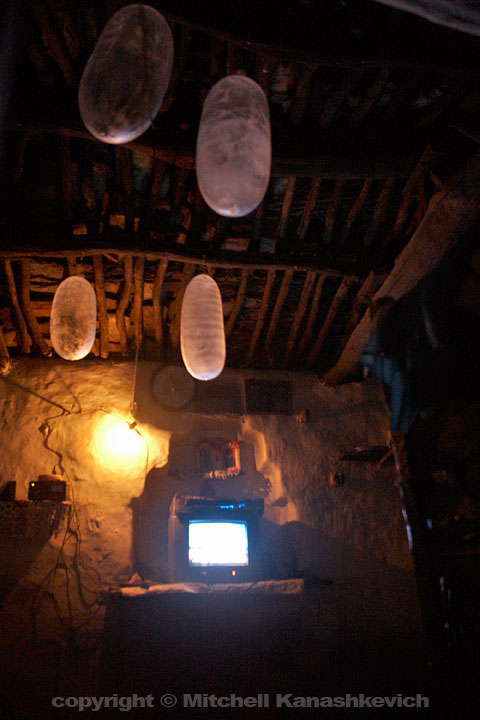I'm trying something different today. I've always considered that one of the best ways to learn photography is through looking at images and deconstructing them, or if possible, finding out the story behind them from the photographer. It is not so often that a photographer goes "behind the scenes" but I know that there should be some curious folks out there, who like me would love to see that kind of stuff.
Merry Christmas from Addis Ababa
My dream has finally come true. I’m in Africa! Addis Ababa, Ethiopia, to be exact. Well, ok, the Addis Ababa part of it is far from a dream. To me the city seems like one big tragedy of humanity - a strange fuse of colonial and socialist architecture as well as tin-shacks that make up most of the small shops and all the slum dwellings. The city is overwhelming in many different ways - beggars, street hustlers, noise, pollution - a little of everything. Nevertheless, this is Africa! I have wanted to come here since I was a child and now I’m here at last.
Manila - markets, malls and lit-up jellyfish
New eBook - Journey Through Java
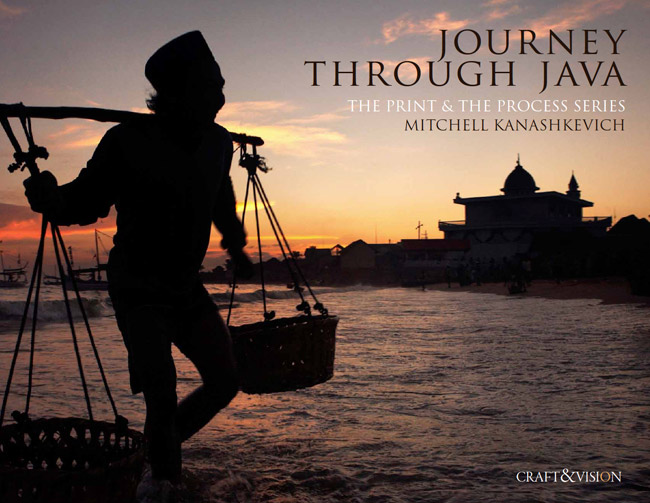 Hello good people of the Cyberworld! I have a new eBook out! As you probably gathered from the image above, it’s called “Journey through Java”. This one is a collaboration with David duChemin’s “Craft and Vision” team and it is a part of their very popular “Print and Process” series. Basically, it’s my photos and words, their structure and design.
Hello good people of the Cyberworld! I have a new eBook out! As you probably gathered from the image above, it’s called “Journey through Java”. This one is a collaboration with David duChemin’s “Craft and Vision” team and it is a part of their very popular “Print and Process” series. Basically, it’s my photos and words, their structure and design.
Those of you who have been following my blog for some time are aware that I have known this duChemin fellow for a while. I think quite highly of the man, so when David approached me about doing one or possibly even a few eBooks for the “Print and Process” series, I said - “Sure thing mate!”
What really excites me about this eBook is the fact that the structure of it allowed me to focus on a specific stretch of time during my photographic journeys and as a result I was able to delve deeper into my photographic process than ever before. The eBook is fairly personal, but at the same time, the knowledge one should come away with is applicable on a very wide scale.
There’s talk about the equipment used, the technical aspects (every image has the Exif data provided) as well as composition and light. These things are all discussed in a very practical sense, as they relate to the images included in the eBook. There is a somewhat philosophical side to what I’ve written too. In this eBook I really wanted to touch on what makes a photograph more than a snapshot or an overused cliché and so I’ve devoted a whole section to the discussion of what it means to create shots that are deep, original and express what the photographer feels to the fullest.
Who is this eBook for? It is for anyone who enjoys my photography and wants to know how I go about creating my work. I do however feel that the eBook will be particularly useful for the serious amateurs who want their photos to be more than “pretty pictures” as well as those thinking of doing travel and documentary photography for a living.
The really good part for all of you strapped for cash is - it’s only $5! And if you use the promotional code JAVA4 as you check out from Paypal, you’ll get it for $4 (offer expires 11:59pm PST October 3, 2010).
To purchaseor for more info, head over to the “Craft and Vision” site HERE or click the cover shot at the top. As always, your support is really appreciated!
I’m still in Port Villa as I write this, but heading home soon. More photos and hopefully some videos to come soon.
South West Bay, Malekula – Where pristine nature meets ancient traditions
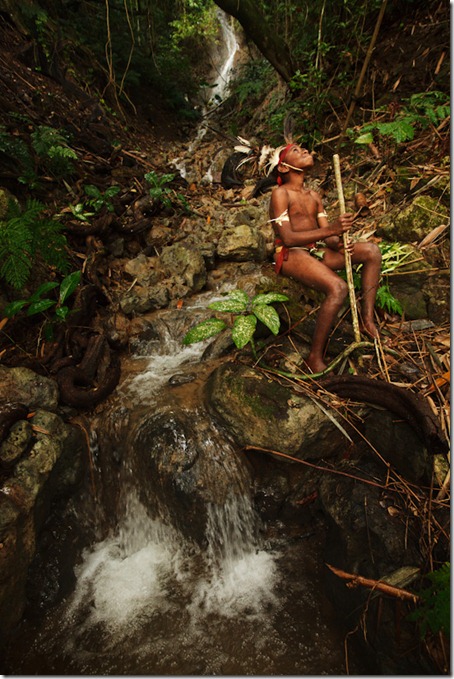 A few posts ago I mentioned that I got involved in helping some locals with the promotion of their regions as tourism destinations through my photographs. In fact I not only ended up doing the photos, but also dished out quite a lot of advice, since the people on most islands of Vanuatu (besides two main ones – Vila and Santo), well they don’t have much of an idea of what foreigners actually want and their misconceptions could not be further from the truth. That is of course very understandable, since their culture and general approach to life could not be much more different from that of “white people” or most foreigners in general.
A few posts ago I mentioned that I got involved in helping some locals with the promotion of their regions as tourism destinations through my photographs. In fact I not only ended up doing the photos, but also dished out quite a lot of advice, since the people on most islands of Vanuatu (besides two main ones – Vila and Santo), well they don’t have much of an idea of what foreigners actually want and their misconceptions could not be further from the truth. That is of course very understandable, since their culture and general approach to life could not be much more different from that of “white people” or most foreigners in general.
For the moment and likely for at least five years or more, most of outer islands of Vanuatu (as all the islands outside of Efate where the capital is located are called) are pretty darn far from being “real” tourist destinations. I mean this in the sense that they are not particularly suitable for those who want to relax in comfort, eat well, drink or party. Outside of about three major towns, there’s no electricity, running water is very uncommon and perhaps the most painful thing, at least for me, is that the locals, for most part could not care less about what they eat. There’s no food culture, which equals to no tasty local cuisine as you get in most places around Asia or elsewhere where there is a food culture.
All the minuses aside, Vanuatu offers something that few places offer these days and that is untouched, pristine and absolutely stunning nature. On top of that the people (the Ni-Vanutatu or Ni-Vans, as they call themselves) are some of the most charismatic, friendly and likeable on the planet. There’s also no hassle, no one attempts to sell you crap that you don’t need, no one tries to trick you or rip you off. As much as I love places like India, Nepal and Indonesia, it gets pretty annoying when people constantly see you as a money bag and come up with the most ridiculously creative ways of making you part with your money. You just don’t have that in Vanuatu, at least not yet.
Besides the already mentioned virtues, there’s of course the culture. As I also mentioned in a past post, the culture is undeniably disappearing, but it hasn’t disappeared yet, at least not everywhere. And while there are still places where you can experience this incredible culture in at least some shape or form, you have to go. In some very strange way it appears that the foreign interest in the culture of Vanuatu’s islands has made a lot of Ni-Vans realize just how precious their culture is. At the end of the day, it may very well be tourism which will help ensure that not all is completely lost.
But let me now get specifically to South West Bay. It is one of two regions which I photographed with the aim of helping promote it. As you might have already gathered I am also ready to promote it through my blog and the internet in general, but that doesn’t mean that I’m simply going to sugar-coat everything. I’ll tell the truth, and in this case the truth is good enough to get people to come.
My idea to do this little project came after I met a good man by the name of George Thompson. George was born and grew up in the very remote South West Bay, Malekula. Through some visionary thoughts, hard work and twists of fate he was able to become the leading tour operator and the head of the tourism department in his region. This role even gave George an opportunity to travel to Europe for a tourism expo in the late nineties. He saw places that very few Ni-Vans get to see – France, Germany, Denmark. While he loved the experience, travelling abroad made him realize that things back home were not as bad as some of his fellow countrymen had imagined. Sure, Vanuatu is a poor country by Western standards, but paradoxically there are no homeless people and no one begs for money or food. On top of that the air is fresh and the culture is rich.
When George got back, he had become even more inspired and passionate about showing off his region to the occasional tourists. By 2000 things were looking good, tourist numbers were slowly growing and the income that tourism provided made people’s lives just a little easier. However, things in Vanuatu can change rather quickly. Corruption and “mismanagement” of funds at the higher level are common and around 2004 the nationwide tourism company “Island Safaris” the branch of which George led successfully in South West Bay went down due to “mismanagement”. Tourism numbers started to decline faster than they rose, without the support of a bigger company there was no way that George or the locals could market their region to the outside world. To add even more pain to the dilemma, the airport of South West Bay was sporadically closing and opening, thus making it harder for anyone to get to the area. In a couple of years there were virtually no tourists visiting South West Bay.
Because of George’s past friendships and connections he was able to get a good job, managing a small resort in Port Villa. He had a relatively easy life and a high salary, by Vanuatu standards. George worked at the resort for a couple of years, but soon he became haunted by the thoughts of home. He was away from his family and he knew that while he was having it easy, the people of South West Bay were struggling. He felt pain and guilt and before long he got back to South West Bay with the hopes of reviving the small, but once stable tourism industry that he helped build.
Fast forward to 2010 and things are not looking so bright. Over the past few years tourism has still been near non-existent. Instead of helping bring up the lifestyle of others, George found himself in a similar situation as them. He didn’t tell me his story when I met him, he’s not the kind of person to whine or complain about life, that doesn’t seem to be part of the Ni-Van mentality in general. Instead I got all of this information out of him during the two weeks that I spent in the area, this of course made me even more motivated to help the man in at least some way.
The particular idea about me making some photos came after George showed me some of the past photos of the places in his region sent to him by tourists. According to his stories, the places were beautiful and the people in those places fascinating and so when I saw images that were let’s say not very inspiring I felt a little uninspired myself. I know that I’m not the only one who gets excited about a place by seeing a single beautiful image of it and so with that thought in mind I suggested that we create a little tourism marketing campaign. The campaign would be a combination of documentary images of some of the more photogenic activities, places in the region, as well as some set up shots of the locals dressed in their traditional costumes in their beautiful surroundings.
For me personally the shoots were a reward in themselves. I have been shooting documentary stuff for years and I’m always interested to be placed into new photogenic situations. As far as the set up shots, it was in a sense even more fun to do them. I’d made a couple of short fiction films while at uni and photo shoots of this sort, while fairly new to me were in a some ways similar to making short films. In this case you could say that the shoots were a blend of fiction and documentary (the line was very thin). Our “actors” had to be themselves, they simply had to be in specific locations, wearing costumes which they used to wear in the past and still wear during celebrations or as was customary for the chiefs and some village members while greeting visitors (i.e. tourists). The dances, which are a big thing in the region are performed in similar outfits, (usually more elaborate) so all in all the images we created showed what was most visually exciting about the region of South West Bay and something that the visitors would get a chance to see themselves.
And so let me get to the photos. This is a just a portion of the images I created, you can see more HERE and in the coming months. The image at the top is of one of the boys (Pillison was his name) who I had seen performing the kastom dance at a pig killing ceremony a couple of days earlier. I wanted to photograph him in a similar costume in front of the waterfall, one of the hidden little gems of the area.
Pillison was a great model so we got him and his little mate into a canoe and asked them to row along the shoreline a little. For full impact, I expect this or a variation of this image to be shown in a bigger medium than the 450 pixel photo on a blog. You can get a better view by clicking on the image (to make it larger). Mountains and sea always look dramatic to me and more so when they’re bigger.
This is Chief Ayar again. I blogged about him HERE. I took quite a few shots of this fascinating man. I expect that some of them will be used in something like a brochure, while I’d like to use others, like this one along with images that make up a story, which, if things work out will hopefully appear in some of Vanuatu’s tourism magazines.
A moment from the pig-killing ceremony. During my stay in South West Bay, two chiefs “upgraded” their ranks. Two pigs were killed and meat was shared with the villagers.
Every pig killing is preceded by a traditional or kastom dance. Only certain individuals are allowed to take part. The young are once again being taught the steps of the dances as part of a cultural revival in South West Bay.
For those who like hiking, there’s a fascinating hike to the creepy ancient burial site in the hills above the village of Melmes. The guide, a young chief by the name of John was very passionate in telling us about the history of his people. Below those skulls is a mass burial hole, but before the bodies were placed there they were put onto a high rock. Because John’s tribe thought that they descended from the eagle, they had a little custom associated with this bird. They believed that if the eagle were to eat the eyes of the dead body (when it was placed on the high rock), that person would go directly to paradise, if not, well they go to hell. When I asked John whether many of the dead actually had they’re eyes eaten and went to Paradise, he replied with an uneasy smile – “No, most of our ancestors went to hell.”
Mat-weaving is one of the women’s main occupations. They weave mats for home as well as for sale in big towns like Port Villa in order to generate a small income that usually contributes to the ridiculously high school fees they must pay for their children each year.
Another documentary image taken inside of the village bakery. The baker is cleaning out the ash before putting the bread inside the oven. Once I am home, near a fast connection I’ll try to post some video that I did in this very atmospheric little spot.
George’s uncle is one of the highest chiefs in South West Bay, people like him are an “attraction” in their own right, they are living history and chatting to folks like that is always a highlight of any trip. George’s uncle (his name escapes me, it was a long traditional name, not a Western one) had never had a white man in his house before, so he felt a little nervous when I came to photograph him there. He still had reservations about white people in general because in his youth the presence of a white man was usually bad news. He signed to me that they used to kill the locals by making the cutting of a neck gesture with his hand.
My presence I was sure left him pretty puzzled. I was using the off camera flash in a soft box, which meant that I’d click the button on the camera and the flash would go off (away from the camera). George later confirmed that the flash was indeed a source of bewilderment and amusement as his uncle told fellow elders “This white man came to take my picture. He pressed the button in one place and then this bright light would go off in another place! He’d talk to his woman, she’d press something on the thing that makes the light and then the same thing would happen again, over and over!”
South West Bay is stunningly beautiful. I am not a landscape photographer, but even I was seduced by the scenery of dramatic, red, cliffs and greenery lining the shore. There are much more scenes for the landscape photographer and if I was one of them I’d probably stay even longer.
More beautiful nature (click the image for larger size) and another youngster in a canoe. This is in fact a lagoon about a half hour’s walk from George’s house. Beautiful place, warm people and you only have to dip the net in for a few minutes before you catch fish. Once the traditional owner of this area builds a thatched bungalow, this will be a great place to spend a couple of days.
Just a few hundred meters from the lagoon, you come to this place, which made me feel a little like I was in a forest in Europe. The setting sun made for a perfect lighting scenario and I couldn’t resist making a couple of exposures.
Some final words: For those who are into photography and interested in visiting Vanuatu there are some good news. Through working with me George learned a good bit about what sort of stuff more serious photographers might be interested in. In other words he knows that we don’t like cheesy pictures of kids giving us the thumbs up (very common in Vanuatu) or people standing with their hands by their sides like soldiers before a march. He also understands that sometimes real life is the most fascinating subject of all, so he can help the photographers get access to shoot stuff like that.
I might be doing a workshop in Vanuatu at some stage and if I do there will only ever be one. However for the more independent minded or more advanced photographers, I highly recommend you to get over to South West Bay and to let George show you around. I’ve only scratched the surface here. There’s reportedly a great reef for those who love shooting underwater (I had left my housing near the airport not knowing this) you can go on a wild pig hunt with a couple of dudes with bush knives and a pack of dogs. There are more traditional villages and fascinating elders in the mountains and some folks shoot river fish with bows and arrows.
Oh and did I mention that the whole thing will be extremely affordable, especially by Vanuatu standards? Whatever you pay will go directly to the community, there are no middle-man organizations (as is often the case when you do things through bigger companies). I don’t get anything out of it apart from satisfaction in knowing that I helped someone. I’ll post more on the prices and the possibilities at a later stage, but if anyone is already interested, feel free to contact me via this blog or the email on my website.
Transcending Travel – my new eBook
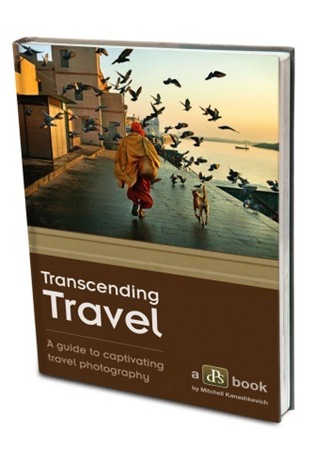 Just wanted to pass the word that my new eBook, which I did for “Digital Photography School” is out. I’ve put a lot of work into this one and I’m pretty over the moon about the fact that Darren Rowse, who is the founder of DPS (which happens to be the biggest photographic community on the web) decided to team up with me for this eBook. Darren is definitely one of the gurus of social media, he also runs the extremely useful and popular ProBlogger, it’s always an honor to be associated with people like that, who are at the top of their game.
“Transcending Travel – A Guide to Captivating Travel Photography” is ideal for beginners and intermediates, but even if you’re a seasoned shooter I hope that it can provide you with some inspiration and food for thought or just give you a look at how I do things photographically.
Just wanted to pass the word that my new eBook, which I did for “Digital Photography School” is out. I’ve put a lot of work into this one and I’m pretty over the moon about the fact that Darren Rowse, who is the founder of DPS (which happens to be the biggest photographic community on the web) decided to team up with me for this eBook. Darren is definitely one of the gurus of social media, he also runs the extremely useful and popular ProBlogger, it’s always an honor to be associated with people like that, who are at the top of their game.
“Transcending Travel – A Guide to Captivating Travel Photography” is ideal for beginners and intermediates, but even if you’re a seasoned shooter I hope that it can provide you with some inspiration and food for thought or just give you a look at how I do things photographically.
You can find more info HERE or by clicking on the picture above. This week there’s a 25% off special and there are also some pretty cool incentives, check out the links for more.
That’s all from me for now. More to come soon.
Back from my hiatus
Hi folks! Wow, it’s been about 3 months since my last post. I realize that posting once every 3 months is a great way to lose most of my readers, but hey, what can I say, I haven’t had much writing left in me lately.
The thing is, I had undertaken a pretty big project. In collaboration with The Digital Photography School I’ve written another eBook, this time on Travel photography. That’s a pretty darn broad topic, so naturally it took me a while to get the whole thing done (though longer than I expected). In the process I just really didn’t have the energy to write anything on my own blog, nor did I take any photos. I don’t know how the heck guys like David duChemin (at Pixelatedimage.com) manage to blog a few times a week, but then again even he has been pretty sparse of late, due to all the traveling.
I also have to update all of you who applied for the “Join me” trip on a motorcycle from Bali to the tribal villages of Flores. Sorry to say, but it ain’t happening this year, nor is the other private photo workshop. I’m kinda surprised by how much interest these generated, since I never actually advertised them anywhere, nor even blogged about them. In any case, I think I’m most likely going to stay away from the face to face, non-virtual workshops for the next couple of years. I just feel like I want to use my time on the road to educate myself for now, to keep taking my own photography to the next level. Nevertheless, I’ve put a lot of my knowledge into the Travel Photography eBook, so if you’re hungry for knowledge, if you want to know how I do things, it’s definitely worth checking out, stay tuned here and on the Digital Photography School site this week to find out more.
As I mentioned, I haven’t done any photography or at least no significant photography since I’ve been back in Sydney. So that’s about 4 months without doing any meaningful photo taking. Such is the nature of this way of business/lifestyle – you take photos for months and then you work on them for months, so that you can actually get them out into the marketplace or in front of the public.
I recently finalized a contract with Corbis Images, so now I’ll be represented by two of the world’s “favorite” stock photo agencies. This means more work sorting through the images and that’s exciting and overwhelming at the same time.
Now to some fun news, I hope to begin adding video content to this blog starting from my next journey. It’s something that I want to make a big priority in the not too distant future. It’ll be a mixture of adventure/travel videos and some behind the scenes stuff, which will hopefully be educational for all the aspiring travel photographers or for just anyone curious about what happens on such trips, how the photos are actually created.
Ok, so that’s about all for today. I’ll be blogging regularly again. To all of you who haven’t forgotten about me – thank you. To all those who have – I hope that you’ll find the new content of this blog interesting enough to come back.
For now I leave you with an image from a Ukranian magazine “Digital Photographer”. They did a pretty long story on my travels and images a couple of months back. The whole thing is kinda funny because they interviewed me in English (easier for me than Russian, though I speak it) and the way they translated what I said made me sound much more intelligent than I actually am, or perhaps more well-spoken in Russian. The title of the feature is “Messenger from the people”. If any of you are in that part of the world, perhaps you can get your hands on the magazine and check it out.
Ok, off for now, but I’m back in the blogosphere, so stay tuned.
Greetings from the Holy Land!
Hi folks, it’s been a long time since my last post and in case you’re thinking that I’ve been buried somewhere in the snows of cold Belarus, you’re wrong. :)
I’m actually in Israel. It’s not a random trip, I’ve had family living here for a while and it was time for a way overdue visit. I won’t get into all the personal details, but rather keep it photography related. A couple of days back I’ve managed to do something I’ve wanted to do for quite a while – go back to Jerusalem.
I visited the “Holy City” in the past, when I was about 13 (with my parents). As a teenager, I was raised on Christian beliefs and was familiar enough with the Bible to know the significance of Jerusalem. Even back then it felt special.
These days I’m not attached to any religion, but having been exposed to other faiths and life-experiences, I can appreciate the city more than ever before. In reality it’s hard not to appreciate Jerusalem. The old town’s ancient architecture, labyrinth-like streets, bustling markets and hordes of devotees of all races, colours and faiths make it a city like no other on Earth. The closest thing I’ve experienced to Jerusalem was travelling through the old cities of Rajasthan, India, but even they don’t match Jerusalem’s incredible diversity.
I spent most of my time around the famous symbols of the world’s dominant religions – the Church of Holy Sepulchre, the Wailing Wall and the Golden Dome Mosque. That’s where the images you see here are from.
Mine and Tanya’s stay was made much more special thanks to meeting a talented photographer and a super nice dude named - Sasson Haviv. I got in touch with him on the photography site 1X.com a while back and after I randomly emailed him and told him that I was gonna be in Jerusalem, Sasson was all too happy to meet and hang out. He helped me gain an insider’s view, which is something I treasure whenever I go somewhere new. You can check out some of Sasson’s images right HERE.
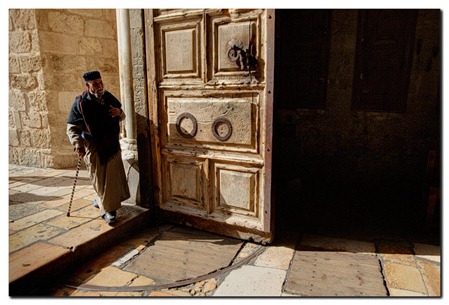 An Ethiopian priest enters “The Church of the Holy Sepulchre”. The church became one of the favourite photographic places I’ve been in. There’s a lot happening, there’s a great variety of faces, the light is different in different places and at different times of the day. You can just sit in one spot, people-watch and wait for something photo-worthy to happen.
An Ethiopian priest enters “The Church of the Holy Sepulchre”. The church became one of the favourite photographic places I’ve been in. There’s a lot happening, there’s a great variety of faces, the light is different in different places and at different times of the day. You can just sit in one spot, people-watch and wait for something photo-worthy to happen.
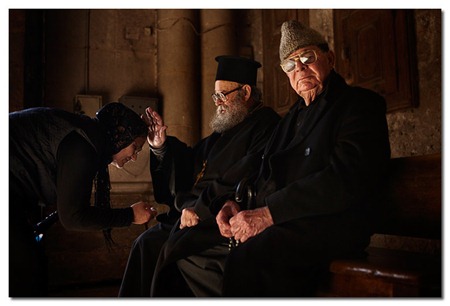 A priest blesses a devotee. I shot this image at the same spot as the photo above, but a bit later on in the day and obviously from a different angle. It’s possible to spend weeks here.
A priest blesses a devotee. I shot this image at the same spot as the photo above, but a bit later on in the day and obviously from a different angle. It’s possible to spend weeks here.
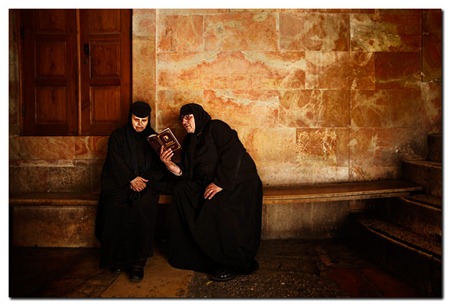 Two Orthodox nuns absorbing a passage from the Bible. Still the same area, but the opposite side by the entrance to the church.
Two Orthodox nuns absorbing a passage from the Bible. Still the same area, but the opposite side by the entrance to the church.
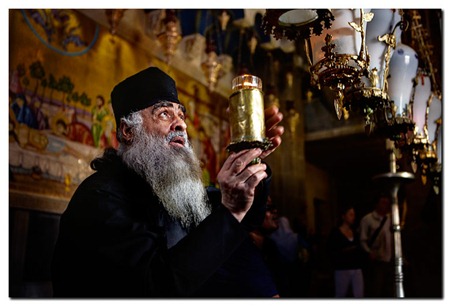 A Greek Orthodox priest changes oil in the lamps above the stone-plate where Jesus’ body is said to have been prepared for burial.
A Greek Orthodox priest changes oil in the lamps above the stone-plate where Jesus’ body is said to have been prepared for burial.
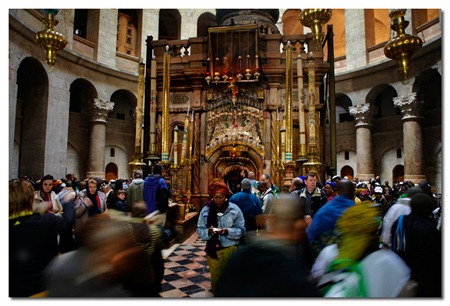 A crowd of devotees around the Holy Sepulchre / The Tomb of Christ. There seems to always be a crowd around it. As holy as the place may be, this is where I saw the less magical side of the church. The person in charge of directing the crowd, usually a monk would tell everyone when it’s time to get out . He’d commonly say - “Hey, come on, you don’t get one hour here, move on!” He would also knock back those who try to squeeze-in without waiting in line. I saw an elderly Russian couple say “Can you please let us through, we are pilgrims.” The answer - “Guess, what? Everyone’s a pilgrim here, get in line!” At one stage the crowd started to get out of control and the monk started screaming almost uncontrollably for them to get back, I guess it was time for desperation.
A crowd of devotees around the Holy Sepulchre / The Tomb of Christ. There seems to always be a crowd around it. As holy as the place may be, this is where I saw the less magical side of the church. The person in charge of directing the crowd, usually a monk would tell everyone when it’s time to get out . He’d commonly say - “Hey, come on, you don’t get one hour here, move on!” He would also knock back those who try to squeeze-in without waiting in line. I saw an elderly Russian couple say “Can you please let us through, we are pilgrims.” The answer - “Guess, what? Everyone’s a pilgrim here, get in line!” At one stage the crowd started to get out of control and the monk started screaming almost uncontrollably for them to get back, I guess it was time for desperation.
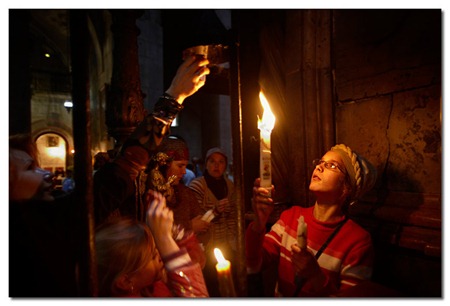 Just by the tomb is where I continuously saw Russian tourists/pilgrims obsessively burn the fuses of candles which they had bought in the church or brought with them (such is the tradition and it makes the candles blessed in a way). They would buy whole bags of them and would greedily burn the candle-fuses, one bunch after another. Well, at least that gave me a chance to get some shots.
Just by the tomb is where I continuously saw Russian tourists/pilgrims obsessively burn the fuses of candles which they had bought in the church or brought with them (such is the tradition and it makes the candles blessed in a way). They would buy whole bags of them and would greedily burn the candle-fuses, one bunch after another. Well, at least that gave me a chance to get some shots.
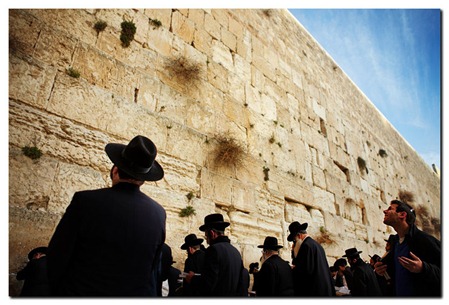 Devotees praying at the “Wailing Wall”. I have to admit, I know relatively little about Judaism, perhaps that was one of the main reasons I felt less comfortable shooting at the wall. Ok, that and the fact that thousands of tourists photograph these same people here every day, thus annoying the heck out of the them. There’s about a 50/50 percent chance that you’ll be asked to stop. It’s a tricky situation, because when you see someone in a moment of religious ecstasy, doing the “decent” thing and asking is not necessarily an option. If I had more time, I would come back and do what Sasson does – make friends with some of the worshippers and get their consent before shooting in a more intimate way.
Devotees praying at the “Wailing Wall”. I have to admit, I know relatively little about Judaism, perhaps that was one of the main reasons I felt less comfortable shooting at the wall. Ok, that and the fact that thousands of tourists photograph these same people here every day, thus annoying the heck out of the them. There’s about a 50/50 percent chance that you’ll be asked to stop. It’s a tricky situation, because when you see someone in a moment of religious ecstasy, doing the “decent” thing and asking is not necessarily an option. If I had more time, I would come back and do what Sasson does – make friends with some of the worshippers and get their consent before shooting in a more intimate way.
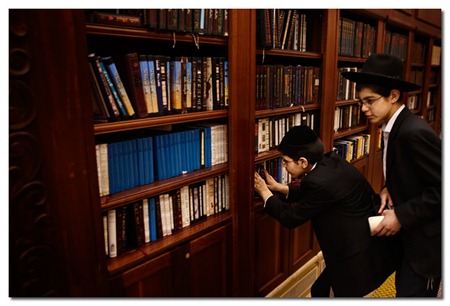 There’s no shortage of knowledge by the Wailing Wall. In the undercover area to the left religious books are aplenty and you always see someone looking for something or putting a book back on the shelf.
There’s no shortage of knowledge by the Wailing Wall. In the undercover area to the left religious books are aplenty and you always see someone looking for something or putting a book back on the shelf.
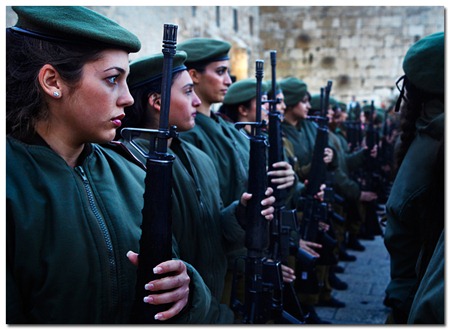 Female soldiers rehearsing for “the end of army service” ceremony by the “Wailing Wall”. The sight of women in army uniforms and with guns is quite unusual for most people around the world, but it’s just an everyday occurrence in Israel. When I came across the scene I couldn’t resist shooting quite a few frames. It is funny that despite such seemingly serious duty, the girls (who are all probably in very early 20s) joked around, made bored faces, occasionally made faces at me and one even stuck out her butt for the camera.
Female soldiers rehearsing for “the end of army service” ceremony by the “Wailing Wall”. The sight of women in army uniforms and with guns is quite unusual for most people around the world, but it’s just an everyday occurrence in Israel. When I came across the scene I couldn’t resist shooting quite a few frames. It is funny that despite such seemingly serious duty, the girls (who are all probably in very early 20s) joked around, made bored faces, occasionally made faces at me and one even stuck out her butt for the camera.
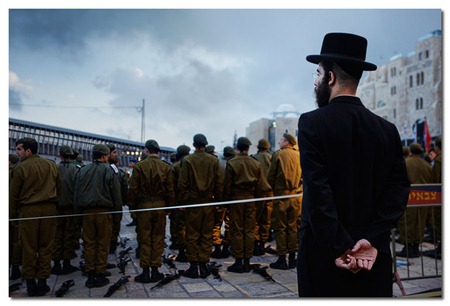 There is the ever-present contrast of the religious and the secular in Jerusalem.
There is the ever-present contrast of the religious and the secular in Jerusalem.
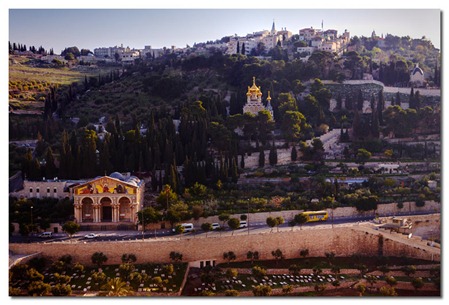 View of Jerusalem from the side of the Golden Dome Mosque.
View of Jerusalem from the side of the Golden Dome Mosque.
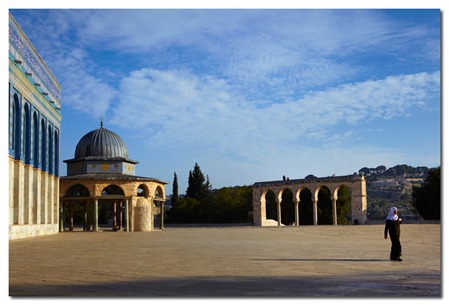 Morning around the Golden Dome Mosque.
Morning around the Golden Dome Mosque.
 At the market by Old Jerusalem’s Damascus Gate.
At the market by Old Jerusalem’s Damascus Gate.
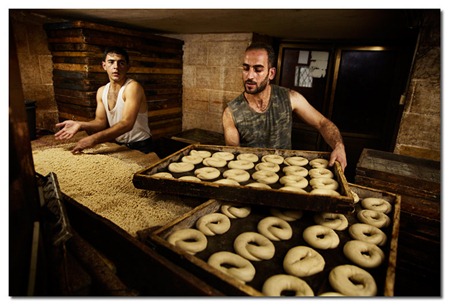 Thanks to Sasson we were able to get into this bakery after-hours and take some photos of these two Palestinian brothers at work. They were real nice guys. After we finished shooting, we were offered some of the sweetest tea I’ve ever drank, not necessarily a good thing, but a a sign of the famous Middle-Eastern hospitality Sasson told me about.
Thanks to Sasson we were able to get into this bakery after-hours and take some photos of these two Palestinian brothers at work. They were real nice guys. After we finished shooting, we were offered some of the sweetest tea I’ve ever drank, not necessarily a good thing, but a a sign of the famous Middle-Eastern hospitality Sasson told me about.
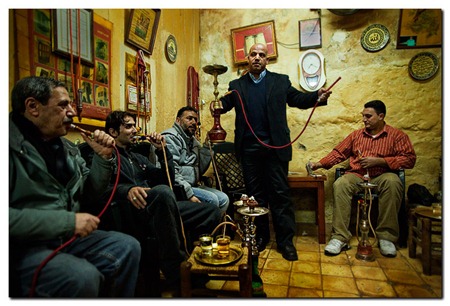 In this place Palestinian men enjoy a smoke of their pipes and play cards. I was quickly told that some of the older, more classy pipes cost as much as 2500 Euros. One of the guys collected them and said that when he smokes his expensive pipe the experience is as great as being with a beautiful woman.
In this place Palestinian men enjoy a smoke of their pipes and play cards. I was quickly told that some of the older, more classy pipes cost as much as 2500 Euros. One of the guys collected them and said that when he smokes his expensive pipe the experience is as great as being with a beautiful woman.
That’s all from me for now. I’ll be flying back to Belarus in a couple of days, I hear it might be –30C by then! Aaah!!!
On David duChemin and his eBooks
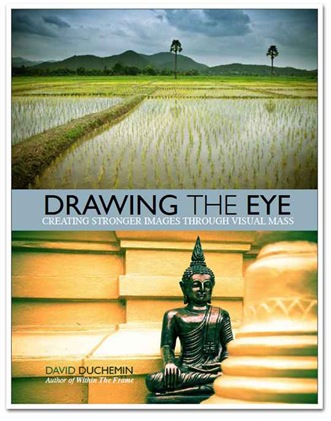 I feel that David duChemin is one of the best photography writers out there today. Perhaps some may think we’re conspiring by praising each other on our blogs every now and then, but what can I say – I respect the man as a photographer and I absolutely love the way he writes. Is that so wrong? :)
I feel that David duChemin is one of the best photography writers out there today. Perhaps some may think we’re conspiring by praising each other on our blogs every now and then, but what can I say – I respect the man as a photographer and I absolutely love the way he writes. Is that so wrong? :)
One of the things I love most about David’s writing is that while he talks about the philosophy and theory behind photography, he always keeps things very practical. After reading David's stuff you can go out and apply the knowledge to actual, real life situations.
When I first saw the title of David's latest eBook “DRAWING THE EYE – Creating Stronger Images Through Visual Mass” I thought, “Geez that sounds a bit heavy and abstract” but I was pleasantly surprised. Well, perhaps not surprised, because I have come to expect at least a certain amount of brilliance from the man and the last eBook is certainly no exception.
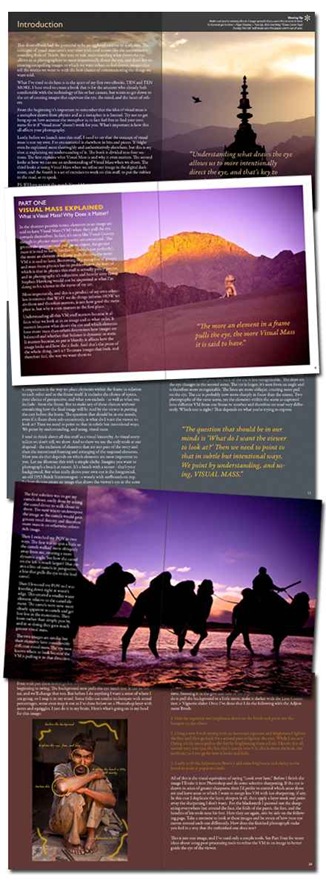
I won’t go into a detailed explanation of what the eBook is all about, I’ll simply direct you to David’s BLOG, where you can read David's own description as well as what other people are saying. I will mention this though; if you’re ready to step it up a notch and to really begin creating images with impact and some thought behind them, rather than simple snap-shots of exotic places and faces then “DRAWING THE EYE” is a must. As David says: “It’ll change the way you look at your craft”. Agreed. Even if like me you already look at your craft much the same way David does I always find that David’s eloquent and humorous writing really hammers home whatever thoughts I had in the back of my mind. He’s able to express his ideas so well and so clearly, the final message, along with the images just inspires you to push yourself a little further each time you lift the camera to your eye. For that I gotta thank the man. :)
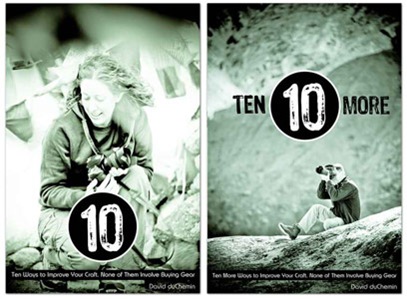
Before I go, I absolutely have to mention David’s earlier eBooks “Ten” and “Ten More” . Again, read about them by clicking on the hyperlink titles. These two eBooks are particularly useful for those in the early stages of their journey into photography, but as is the case with all of what David writes about, anyone can get a surprising bit of inspiration and food for thought from his words. The best part about it all, these eBooks are knowledge that is accessible to almost anyone around the world. At $5 a pop, the price is something that you simply can’t complain about.
You can get all of David’s eBooks RIGHT HERE.
Now a brief word about me. I’m back in Minsk, getting over an annoying cold and finishing some of Tanya’s paperwork to go to Europe. I’ll make one more trip to the region of Braslav for a week or so, finish off some logistics in Belarus and if all goes right, in early November I’ll drive towards Romania, a country, which I have been curious about for too long not to visit it.
Chiaroscuro – Sculpting with light
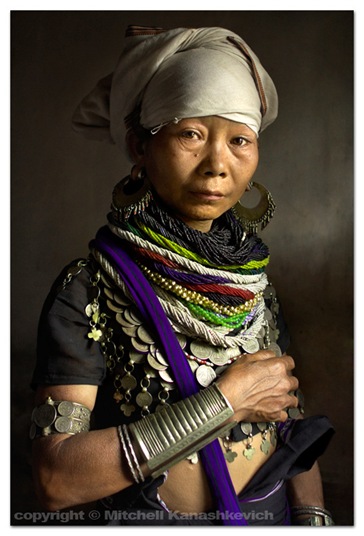 Since I’ve been pretty much consumed by all things light related recently, writing texts for my new e-book, I decided to write a post in the spirit of, you guessed it - light.
When I’m shooting, particularly when shooting portraits I have an obsession with creating a sense of volume and depth, making my photographic subjects appear sculpted, three dimensional. Turns out there has been a word for this “look”, since long before photography. The word is - “chiaroscuro”.
Since I’ve been pretty much consumed by all things light related recently, writing texts for my new e-book, I decided to write a post in the spirit of, you guessed it - light.
When I’m shooting, particularly when shooting portraits I have an obsession with creating a sense of volume and depth, making my photographic subjects appear sculpted, three dimensional. Turns out there has been a word for this “look”, since long before photography. The word is - “chiaroscuro”.
Now, call me an idiot, or a bad student, since I’m sure we learned this in my art history class at university, but when I heard the word from a traveling artist I befriended in Indonesia, I didn’t really know what he was on about.
Of course I put on a smart, understanding face, the first time I heard it, :) but after he used the word a second time, remarking how much he loved the presence of “chiaroscuro” in my work, (which I was showing him) I could pretend no longer :) - “chiaro-what?” He gave me a definition along the lines of what I later found later on Wikipedia:
“Chiaroscuro (Italian for light-dark) is a term in art for a contrast between light and dark. The term is usually applied to bold contrasts affecting a whole composition, but is also more technically used by artists and art historians for the use of effects representing contrasts of light, not necessarily strong, to achieve a sense of volume in modeling three-dimensional objects such as the human body.”
Today, as I was looking at some of my images, trying to explain the natural light in them and to break down into diagrams how it can be managed, I remembered the word and decided to Google it.
Caravaggio and Rembrant are two famous artists known for their mastery of “chiaroscuro”. I’m not making a revelation when I say that they’re masters for a reason. One thing is for a photographer to see the light and to position the subject in a way that will create the “chiaroscuro” look and another is to actually paint it. Every little detail is noticed and needless to say, the work of these artists is inspirational, even a few hundred years after its creation.
One important thing to note is that the masters were able to create compelling images without any of the amazing technology we have today (lighting or photographic). Many still do this there’s something to be said there. We don’t need fancy light set ups, artists have sculpted with light for hundreds of years. The first step for us as photographers is to see the light that is before us and understand how to work with it. There’s no sense in rejecting the creative opportunities that artificial light brings – that would be “counter evolutionary”, but there’s also no reason to ignore the power of natural light.
My stance is all for making the most of available light, in the literal sense of the word – any and all light available to the photographer on the move, that’s what I really want to explore in the e-book.
On a side note: I wander if any of the painters rave on about their gear or debate about which paint or brush is better, as photographers often do?
Some words to aspiring travel photographers
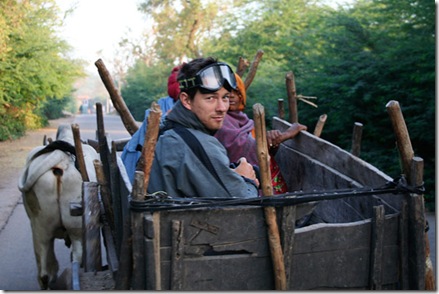 It may be borderline pretentious of me to be offering words to “aspiring” travel photographers, since until pretty recently I was only “aspiring” to do this thing myself. The reason for the post is a question, which I have received numerous times over the past couple of weeks, in various forms:
It may be borderline pretentious of me to be offering words to “aspiring” travel photographers, since until pretty recently I was only “aspiring” to do this thing myself. The reason for the post is a question, which I have received numerous times over the past couple of weeks, in various forms:
How does one become a travel photographer and go on to make enough money in this profession?
At first the question makes me laugh. Who the hell am I to be giving people advice on anything career-related? I’ve never had much of a plan and I always considered that a lot of my success was a result of pure luck. Regardless of whether I’ve changed from an “aspiring travel photographer” to whatever else, I have realized that I am now doing something that many dream of - I travel, take photos and mange to “survive” off the income generated by these photos. On second look I think that there may be reason to my “madness” and perhaps my own story can be useful to other young people starting out. Here it goes. :)
To “become a travel photographer” I worked all sorts of shitty jobs, occasionally committed intellectual and creative suicide by shooting what I consider trash, I used every opportunity in sight to get on the road. There’s an interesting concept I heard somewhere on the net (probably Brooks Jensen’s podcast) - you need to dedicate 10,000 hours to something in order to become proficient at it. Sounds like a fair assumption. That’s basically what I did without realizing. I never quite thought of it as a 10,000 hour thing, but I did know that to be decent at shooting particular themes I needed to shoot them for an extended period of time and so I totally immersed myself in doing just that, while I went off on trips that ranged from six weeks to seven months.
After my third India/Nepal trip (the seven month one) I felt that I really had an idea of what I was doing and incidentally that’s when other things started to click. I began to get published in magazines, had an exhibition and made print sales (more though magazines then from the exhibition). As much as everyone today says that print media is on its last legs, I’ll say that it’s pretty important to get your work published. There’s just a certain type of validity that comes with having your work in print. It means that someone at least thought enough of it to spend their money on the required paper and ink.
With the publications, I saw that my work had some value and I asked myself this question: How can I generate a more regular income from my photos? I looked at image/stock agencies. Got a contract with Lonely Planet Images (on my second attempt), but terminated it before long – this isn’t the place to go into the details, Lonely Planet make great guidebooks… and let’s leave it at that. :)
I still wanted to have my photos represented by an agency, those who are seriously working with the big name agencies know how important they can be and so, I went on a search. A bit of luck, weeks of waiting, empty phone calls and emails, weeks more of being bounced around and I finally managed to get in with Getty Images – everyone’s “favorite” stock selling (not so gentle) giant. :)
This brings me to How do you make enough money? part of the question. Well, it all depends on what you want enough for. A comfy life in inner-city Sydney? There’s a very slim chance that your travel photography will generate enough income for that in the first years. But having your images make you enough to travel and live around the cheaper parts of the world? Very possible, that’s what I do. :)
After a couple of years of very intense photographing and relatively recent, almost equally intense attempts at finding ways to make money from it, I have to say that I’m still very very far from striking it rich. Every month Getty sells some of my work and probably makes me enough to get by in most of Asia. I am still submitting to magazines and looking for alternative incomes from my photos, I’m even still willing to sell my soul, to shoot what I don’t love every now and then. However, importantly I no longer have to do what I don’t like, my images are finally “working” for me. Even more importantly I don’t have to work in retail, restaurants or wherever else just to save enough for the next journey.
But still, in all honesty, the way that me and Tanya (my wife) live is not for everyone. Certain comforts must be forgotten, while you’re on the road with a limited income, you simply can’t afford them.
Of course much of the beautiful, amazing things associated with travel are completely free, but if you ever compare your experiences with those of a friend, who may have traveled the same route as you during his four-week annual holiday, you realize that the pleasure you get out of traveling is very different to his. Your pleasure has a perverted twist. While he enjoys sipping cocktails on a luxury boat-cruise, you jump on a ferry packed with goats, chickens, furniture and dry fish, with lovely fellow passengers who chain-smoke and continuously spit on the floor. The journey exhausts and frustrates, and by the end you reek of that damn dry fish and your own sweat. But you’ve made new friends, learned words in a foreign language and have one heck of a story to tell when you get home. The pleasure comes from the experience and from the fact that you survived it. Your friend didn’t “suffer” on the luxury boat, but nor did he experience the ‘realness’ of actually being in another country, among regular people from a different culture.
If your cup of tea is the ferry ride and you’re really into your photography, then perhaps things don’t need to be very complicated.
I’ll borrow words from Chase Jarvis. He’s not a travel photographer, but unlike me, he really knows what he’s talking about. :)
There are two things you need to succeed: to be undeniably awesome at what you do, and to persevere.
Applies to everything, even travel photography.
(The confused character with ski-goggles above is none other than me. :) I used to wear the ski-goggles when riding the motorcycle. In this image I’m riding in the back of a bullock cart during an early morning in Rajasthan’s, Bundi District. Didn’t get a good picture, but the ride was kinda interesting.
The Spirit of Travel, Cool in the Hills and Tibetan Monks
 If I do not see another Theyyam performance for the rest of my life I will not be devastated. Don't get me wrong, watching these was amazing, surreal, but maybe this is the case of too much of a good thing being not that great. "Theyyam Overload", perhaps. The highlight of our little endeavor into the world of Theyyam must have been the second time we met up with Vipin - the Theyyam artist I mentioned in the previous post. That day, in many ways embodied what travel is all about. It started horribly, we were 'evicted' from possibly the most amazing hotel I've stayed at. Our room's balcony had a view of the Arabian sea. Every morning we watched dolphins splash around within 50 meters from the shore.Long and strange story about the eviction - in short, the hotel was meant for government employees only, but somehow we managed to stay for five days, then some genius finally decided it was enough. The main point is - once you've tasted the good life, it really, really sucks getting back to mediocrity. Getting told to 'vacate' our perfect room and to exchange sea views for views of a sea of traffic on one of the towns busiest and noisiest roads set up what could have been the most disappointing day of our journey, yes the place was that good (and cost about as much as a McDonald's value meal). But that wasn't the end of our bad luck. First we couldn't find any half decent hotel to move to and then my meeting with a professor at the Folklore Academy, the man who had promised to hook me up with some Theyyam artists was cancelled due to an unexpected meeting that could not be put off. I wanted to see him to get reliable information on where I could see more Theyyams. Having been given the wrong information the day before we traveled a couple of hours along a dreadful, traffic filled road for nothing. Now I had to face the fact; I had come to the region to photograph something that I couldn't even find, I really wasn't getting anywhere.
If I do not see another Theyyam performance for the rest of my life I will not be devastated. Don't get me wrong, watching these was amazing, surreal, but maybe this is the case of too much of a good thing being not that great. "Theyyam Overload", perhaps. The highlight of our little endeavor into the world of Theyyam must have been the second time we met up with Vipin - the Theyyam artist I mentioned in the previous post. That day, in many ways embodied what travel is all about. It started horribly, we were 'evicted' from possibly the most amazing hotel I've stayed at. Our room's balcony had a view of the Arabian sea. Every morning we watched dolphins splash around within 50 meters from the shore.Long and strange story about the eviction - in short, the hotel was meant for government employees only, but somehow we managed to stay for five days, then some genius finally decided it was enough. The main point is - once you've tasted the good life, it really, really sucks getting back to mediocrity. Getting told to 'vacate' our perfect room and to exchange sea views for views of a sea of traffic on one of the towns busiest and noisiest roads set up what could have been the most disappointing day of our journey, yes the place was that good (and cost about as much as a McDonald's value meal). But that wasn't the end of our bad luck. First we couldn't find any half decent hotel to move to and then my meeting with a professor at the Folklore Academy, the man who had promised to hook me up with some Theyyam artists was cancelled due to an unexpected meeting that could not be put off. I wanted to see him to get reliable information on where I could see more Theyyams. Having been given the wrong information the day before we traveled a couple of hours along a dreadful, traffic filled road for nothing. Now I had to face the fact; I had come to the region to photograph something that I couldn't even find, I really wasn't getting anywhere.
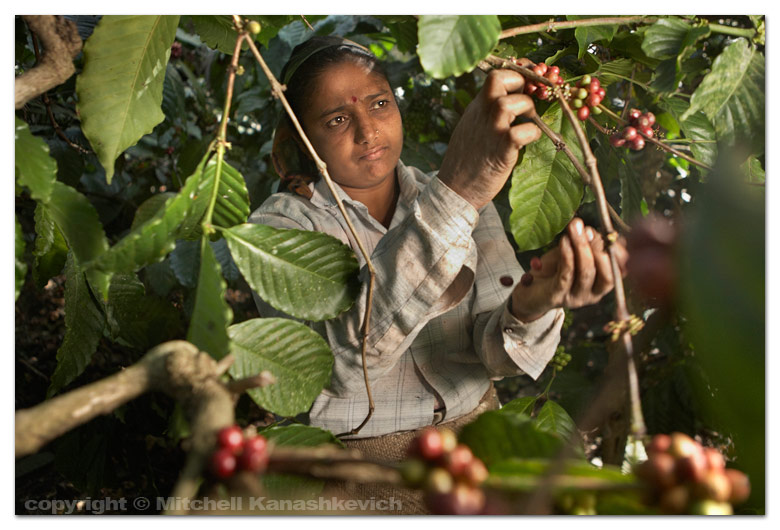 Ready to cry like a child who's been told he's not getting a bicycle after all, I decided instead to go to Vipin's village and give him the Theyyam photos I shot on the night I met him. Vipin was happy to see me and to receive the photos, I couldn't quite match his enthusiasm. But that all changed when he told us that there was a Theyyam performance in his very village. In fact there were two performances that night. These weren't Theyyams aimed at mass audiences, media and tourists, instead I witnessed what was probably as close to Theyyam as it had been hundreds of years ago - raw, sometimes brutal and always full of energy. By late night we had seen a Theyyam performer, possessed by the divine spirit behead four roosters...with his bear teeth, another performer walk through fire and yet another, dance around frantically to some of the most incredible drumming I've heard. We called it a night close to 11pm - real late for rural Kerala. Vipin had been called home a couple of hours before and we were left in the dark, in the middle of nowhere, dependent on our memory to get back. After almost getting lost in the narrow, dark village roads we somehow made it to the main highway that led to Kannur. As we rode the motorcycle back to town, we reflected on the day that pretty much summed up the realities of this life on the road. We were reminded once again that even in the face of the biggest disappointments something amazing could be just around the corner. Knowing that Tanya - my wife was sitting behind me on the bike, ready to face all the obstacles with me also made me realise just how lucky I am.
Ready to cry like a child who's been told he's not getting a bicycle after all, I decided instead to go to Vipin's village and give him the Theyyam photos I shot on the night I met him. Vipin was happy to see me and to receive the photos, I couldn't quite match his enthusiasm. But that all changed when he told us that there was a Theyyam performance in his very village. In fact there were two performances that night. These weren't Theyyams aimed at mass audiences, media and tourists, instead I witnessed what was probably as close to Theyyam as it had been hundreds of years ago - raw, sometimes brutal and always full of energy. By late night we had seen a Theyyam performer, possessed by the divine spirit behead four roosters...with his bear teeth, another performer walk through fire and yet another, dance around frantically to some of the most incredible drumming I've heard. We called it a night close to 11pm - real late for rural Kerala. Vipin had been called home a couple of hours before and we were left in the dark, in the middle of nowhere, dependent on our memory to get back. After almost getting lost in the narrow, dark village roads we somehow made it to the main highway that led to Kannur. As we rode the motorcycle back to town, we reflected on the day that pretty much summed up the realities of this life on the road. We were reminded once again that even in the face of the biggest disappointments something amazing could be just around the corner. Knowing that Tanya - my wife was sitting behind me on the bike, ready to face all the obstacles with me also made me realise just how lucky I am.
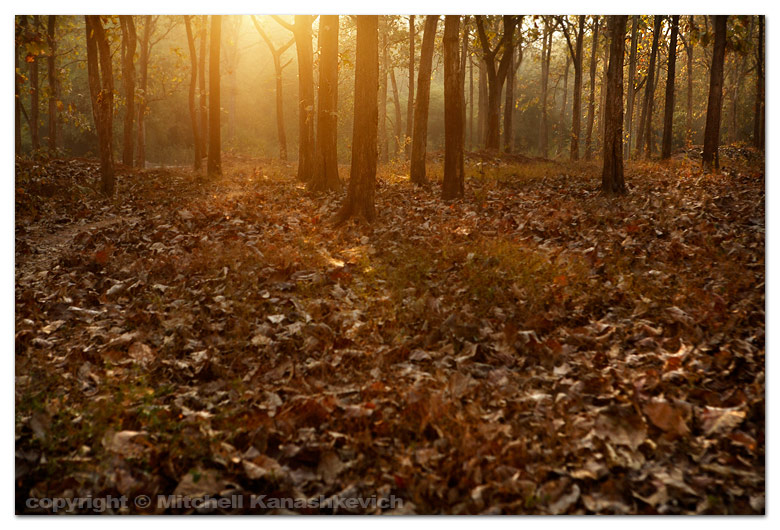 The Theyyam stuff, the heat of coastal Kerala and continuous, hectic rides to the surrounding villages again left us feeling a little drained. We had been contemplating going to Coorg - a hilly region with a cool climate, to refresh for a couple of days, then we'd head back down the coast to Thrissur - one of Kerala's cultural centers. On the map Coorg isn't far from Kannur - 113km. But as always, in India - expect the unexpected. A relatively small patch of the road, known locally as the forest road, was how shall I say - damaged. The damage was so bad that the road looked like it had been bombed continuously for 16 km. I figured that I had traveled on similar roads before, so I didn't make that much of it. BIG mistake! Almost 10km through we started hearing all sorts of noises from our beloved motorcycle. We stopped, I lifted the bike seat and there it was, my worst fear had come true - the motorcycle frame/chasis was broken, snapped right in the middle. To avoid messing things up even more we couldn't continue traveling with all that load and Tanya on the back, and so my poor wife had to walk 6km up a winding, hilly forest road, while I slowly and carefully navigated my way around giant pot holes towards a better road.
The Theyyam stuff, the heat of coastal Kerala and continuous, hectic rides to the surrounding villages again left us feeling a little drained. We had been contemplating going to Coorg - a hilly region with a cool climate, to refresh for a couple of days, then we'd head back down the coast to Thrissur - one of Kerala's cultural centers. On the map Coorg isn't far from Kannur - 113km. But as always, in India - expect the unexpected. A relatively small patch of the road, known locally as the forest road, was how shall I say - damaged. The damage was so bad that the road looked like it had been bombed continuously for 16 km. I figured that I had traveled on similar roads before, so I didn't make that much of it. BIG mistake! Almost 10km through we started hearing all sorts of noises from our beloved motorcycle. We stopped, I lifted the bike seat and there it was, my worst fear had come true - the motorcycle frame/chasis was broken, snapped right in the middle. To avoid messing things up even more we couldn't continue traveling with all that load and Tanya on the back, and so my poor wife had to walk 6km up a winding, hilly forest road, while I slowly and carefully navigated my way around giant pot holes towards a better road.
 We decided to stop for the night at Madikeri - Coorg's biggest town. Our chances of fixing the chasis in this remote region were slim, but Madikeri was our best bet. Again we were facing a very unpleasant situation, but as has happened countless times in India, a stranger came to the rescue. After failed attempts to explain what I need and a few rejections from mechanics and welders who understood, we unexpectedly came across Joe - a catholic Indian man from the coastal city of Cochin. Joe was looking to buy a motor to use for a crop-sorting machine on his spice estate. He came to the same place where we were trying to find out whether our problem can be fixed. After hearing our predicament Joe took it upon himself to help out the guests in his country. The next day his two equally helpful nephews Jeremy and Ronald were involved and although the task became a job of epic proportions (Madikeri is a relatively small town) it was done by the end of the afternoon. It was a little late to head to our next destination and we decided we'd stay another night in Madikeri, that was until Ronald, Joe's nephew called. Ronald found out that I was interested in checking out some tea or coffee plantations/estates and so he invited us over to his estate for the night. We couldn't resist. Another potentially horrible situation had turned in our favor. The next morning we woke up in a mini forest of coffee and pepper bush, as well as some very tall (and apparently expensive) trees. The golden light played it's role in making everything magic. Tanya and I wondered around, appreciated the surroundings and shot a few frames. We expressed our gratitude to our new friends, who saved us and turned a potential disaster into one of the most memorable moments of our journey. Then it was time to move on. Next stop - Bylakuppe - a Tibetan refugee settlement. That's where we are as I type.
We decided to stop for the night at Madikeri - Coorg's biggest town. Our chances of fixing the chasis in this remote region were slim, but Madikeri was our best bet. Again we were facing a very unpleasant situation, but as has happened countless times in India, a stranger came to the rescue. After failed attempts to explain what I need and a few rejections from mechanics and welders who understood, we unexpectedly came across Joe - a catholic Indian man from the coastal city of Cochin. Joe was looking to buy a motor to use for a crop-sorting machine on his spice estate. He came to the same place where we were trying to find out whether our problem can be fixed. After hearing our predicament Joe took it upon himself to help out the guests in his country. The next day his two equally helpful nephews Jeremy and Ronald were involved and although the task became a job of epic proportions (Madikeri is a relatively small town) it was done by the end of the afternoon. It was a little late to head to our next destination and we decided we'd stay another night in Madikeri, that was until Ronald, Joe's nephew called. Ronald found out that I was interested in checking out some tea or coffee plantations/estates and so he invited us over to his estate for the night. We couldn't resist. Another potentially horrible situation had turned in our favor. The next morning we woke up in a mini forest of coffee and pepper bush, as well as some very tall (and apparently expensive) trees. The golden light played it's role in making everything magic. Tanya and I wondered around, appreciated the surroundings and shot a few frames. We expressed our gratitude to our new friends, who saved us and turned a potential disaster into one of the most memorable moments of our journey. Then it was time to move on. Next stop - Bylakuppe - a Tibetan refugee settlement. That's where we are as I type.
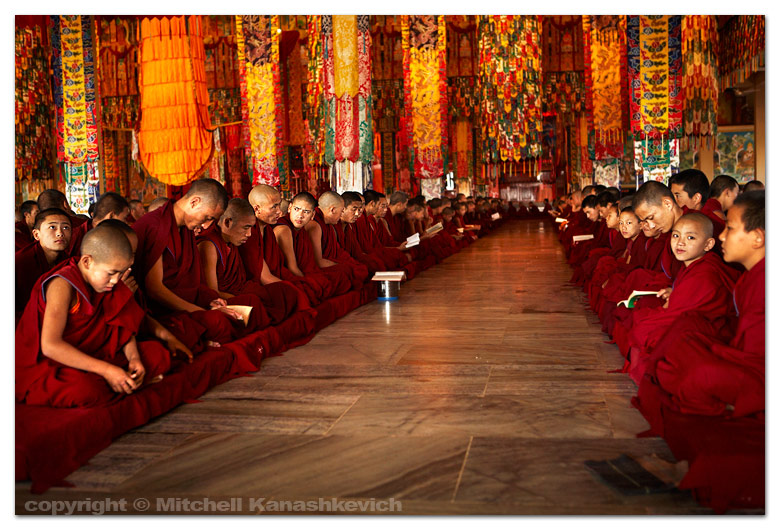 Bylakuppe is a peaceful place, full of maroon robed monks and monasteries. It ain't Himalaya, but there's still something special about it. Monasteries and monks are always photogenic, so we've already spent a few days photographing here. Tomorrow we head off on a little detour, to avoid the dreadful 'Forest Road'. We'll probably end up in Mysore for a few days, then it's on to Wayanad. This cool climate and nature stuff has inspired me to spend some more time up in the hills, in India's forested areas.
Now to the photos. From top to bottom: Monks rushing out after the Morning Prayer, Sera Jey Temple, Bylakuppe. Coffee berry picker at Ronald's estate, Coorg. Morning along the road in Coorg, Kushalnagar region. A mahout washing his elephant at the Dubare Forest Reserve (Forgot to mention we went there. Shot this while standing knee high in water filled with elephant urine and crap ) Bottom: Inside of Sera Jey Temple, Bylakuppe.
Bylakuppe is a peaceful place, full of maroon robed monks and monasteries. It ain't Himalaya, but there's still something special about it. Monasteries and monks are always photogenic, so we've already spent a few days photographing here. Tomorrow we head off on a little detour, to avoid the dreadful 'Forest Road'. We'll probably end up in Mysore for a few days, then it's on to Wayanad. This cool climate and nature stuff has inspired me to spend some more time up in the hills, in India's forested areas.
Now to the photos. From top to bottom: Monks rushing out after the Morning Prayer, Sera Jey Temple, Bylakuppe. Coffee berry picker at Ronald's estate, Coorg. Morning along the road in Coorg, Kushalnagar region. A mahout washing his elephant at the Dubare Forest Reserve (Forgot to mention we went there. Shot this while standing knee high in water filled with elephant urine and crap ) Bottom: Inside of Sera Jey Temple, Bylakuppe.
Floating Condoms, TVs in Mud Houses, or When Modernization comes Unexpectedly
 You can all forget what I said about things not having changed much in Bundi District. We just came back from another overnight stay at a small village where another unexpected surprise awaited us. On the surface everything remains the same, but only on the surface.
You can all forget what I said about things not having changed much in Bundi District. We just came back from another overnight stay at a small village where another unexpected surprise awaited us. On the surface everything remains the same, but only on the surface.
Last evening we visited the home of the lovely woman who became our friend almost 2 years ago and there we saw it – the flickering light of a TV set was shining from inside her stone and mud house, there was a DVD player too and the night’s flick was a B grade film based on a story from the legend of Ramayana. After seeing a computer in a similar village just a couple of days ago perhaps it should not have shocked me at all, but there wasn’t even electricity here the last time we came.
– Are you the only ones to have a TV in the village? We asked. – No, there are four, wait five families as of today. Answered our friend’s youngest daughter.
As we came in and sat down the neighbors began to appear, some came to see us again, others to glance at the aliens from another world for the first time. This time the buzz and the excitement wasn’t quite the same as before though, there weren’t as many curious faces around, no endless questions. Perhaps it was the winter cold, perhaps the novelty factor had worn off, or it could be that our presence was simply not enough to get people away from the few TV sets around the village.
It was a strange scene as we sat by the kitchen fire, Tanya and our friend’s eldest daughter cooked, some neighbors watched them, others were glued to the TV and the more energetic of the children played outside with what they thought to be balloons, but seemed to us like condoms. It was confirmed that they were indeed condoms, brought by some genius teacher to a bunch of seven and nine year olds under the premise that they would be used for sex-education. In reality in conservative rural Rajasthan to talk about sex is somewhat taboo and to tell children what condoms are really used for is not a task any villager wants to take on. Looks like population control will have to wait here.
The cooking and eating dragged into very late evening and going to sleep presented a bit of an adventure. The combination of a shortage of beds and the incredible Indian hospitality caused the following: A couple of families were woken up, children screamed as they were taken off their beds and bundled with their siblings and our friend gave away her only big bed to me and Tanya.
I felt like the biggest ass in the world, realizing that we had caused so much commotion (and children’s tears). I didn’t even care about having a bed, but our hosts were concerned that rats, which frequented the school because of the bags of grain that were stored there would disturb our sleep.
Still, I felt bad, but when I asked Hardik to thank the people that had accommodated us he said that they would be insulted, saying, “ You already know. “In India Guest is God” – a phrase which I have heard many times, but have never stopped to be amazed at just how much it means to the Indian people.
In the morning we woke up to the familiar sounds of domestic animals, the creaking of the water pump and the new, horrendous phenomenon – religious music blaring out of our friend’s home stereo.
Our photo shoots around the area proved that the place is as photogenic as before, Kym was slightly overwhelmed by the opportunities that she was presented with virtually everywhere she looked, but as great as everything was, I felt little sad. I was reminded again; things will not stay this way for very long.
We spent the rest of the day riding around the surrounding villages, visiting homes, getting to know our ‘photographic subjects’. At first glance everything was still the same, but a second look proved otherwise. A few less turbaned elders, a few more rings of the mobile phone in an area where one had to go to the top of a building in a specific spot just to get network coverage.
By the time I’ll post this I will be in Jodhpur – the blue city and a street photographer’s paradise. I’m actually writing this post on the train to Jodhpur, of all places. Turns out some sections of the train have power sockets. Well, I guess development aint all bad.
Images: Top - Kym - the young lady who is participating in our private workshop photographing the rural Rajasthani life. Bottom - Floating condoms/baloons and some entertainment technology in our friend's stone and mud home.

